Abstract
BACKGROUND:
Ultrasonography use is increasing in emergency departments, and ultrasound education is now recommended in resident training. Ultrasound phantoms are used in many institutions for training purposes. The purpose of this study is to describe an inexpensive and simple method to create ultrasound-imaging models for the purpose of education and practice using clear ballistic gel.
METHODS:
Clear ballistic gel is used to simulate tissue for firing practice and other military evaluations.
RESULTS:
The transparent and durable ultrasound phantom we produced was clear and contained four vessel lumens. The images obtained using the phantom were of high quality and compared well to normal sonographic anatomy.
CONCLUSIONS:
The clear ballistic brand gel is unique because it is inexpensive, does not dry out, does not decay, is odorless, and is reusable. The ultrasound images obtained using the phantom are realistic and useful for ultrasound education.
KEY WORDS: Ultrasonography, interventional, Phantoms, imaging, Teaching materials, Emergency Medicine, Medical education
INTRODUCTION
Globally, point of care (POC) ultrasound is increasingly used by emergency physicians, and ultrasound education has become an integral component of residency training.[1] Ultrasound phantoms are invaluable to teach ultrasound-guided procedures and needle-guidance to novice sonographers; however access to high fidelity models is not universal. Commercially available training models, unfortunately, can be expensive, ranging in cost from four hundred dollars to several thousand dollars.[2] Home-made phantoms have a relatively short shelf life and imaging of such material can be suboptimal.[3] Our goal is to describe an inexpensive, reusable and simple method to create ultrasound-imaging models for the purpose of education and practice using clear ballistic gel.
METHODS
Clear ballistic gel is used to simulate tissue for firing practice and other military evaluations. To create a vascular access model from this substance, the following steps are taken. Step 1. Gathering the following materials: oven-safe glassware, standard plastic food storage containers, quarter or half inch plumbing tubing, quarter in or half inch spade drill bit, an oven and one pound of clear ballistic gel (Figure 1). Step 2. The manufacturer sells the ballistic gel in square blocks for $9.52 per pound. The block of ballistic gel is cut into 1-inch by 1-inch cubes to decrease melting time (Figure 2). Step 3. The oven is set to 260 degrees Fahrenheit and the oven-safe glassware containing cubed pieces is placed into it. The material is checked regularly until it has melted completely (in our model the melting time was 1 hour) (Figure 3). Step 4. The plastic food storage container is prepared by cutting holes on both sides of the container with the appropriately sized spade drill bit. The latex tube is pre-greased with any oil-based substance and the plumbing tube is threaded through the holes (Figure 4). Step 5. To prevent disfigurement of the plastic storage container by the heated and liquid ballistic gel, the model is placed into a container filled with ice (Figure 5). Step 6. The melted ballistic gel is poured into the container (Figure 6). Step 7. The gel is cooled overnight. Once the gel hardens, the plumbing tube is slided out and the gel model is removed. The evacuated space created by removing the plumbing tube forms numerous lumens (Figure 7). Step 8. Prior to use, one side of the model is placed into an identical plastic food container without holes in order to seal one end of the lumens and fill the other half of the cannulated cylindrical tracts with liquid (Figure 8). To refill the model, step 8 is repeated or lumens are injected with liquid. In order to reuse the model, the synthetic gel is cut up, reheated, and steps 1–8 are repeated. If the gel material contains small superficial bubbles while baking, heat is continued at low temperatures in the oven until the bubbles disappear.
Figure 1.
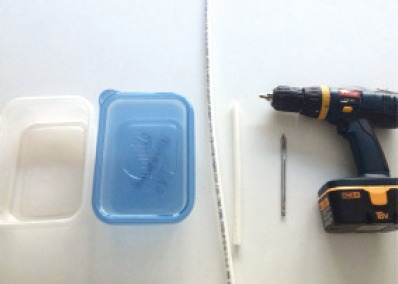
Materials necessary for this phantom.
Figure 2.
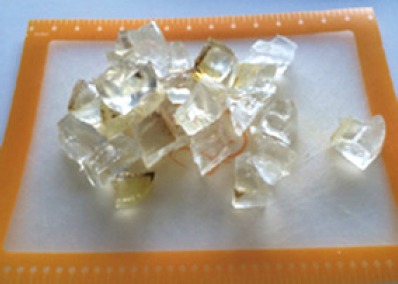
One-inch cubes of ballistic gel.
Figure 3.
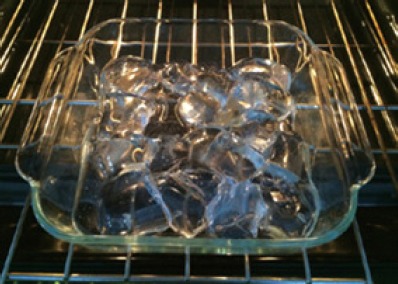
Melting ballistic gel in oven safe glassware.
Figure 4.
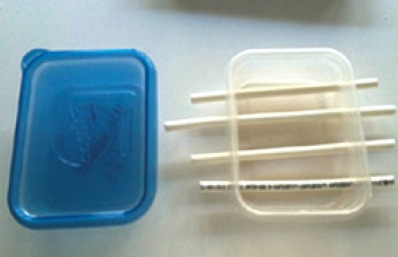
A plastic food storage container with plumbing tubing threaded through holes.
Figure 5.
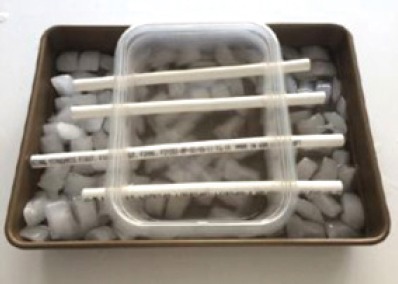
The plastic container placed with plumbing tubing on ice.
Figure 6.
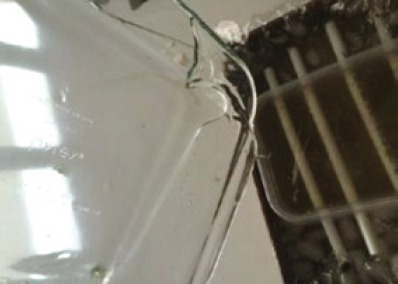
The melted gel poured into the plastic container.
Figure 7.
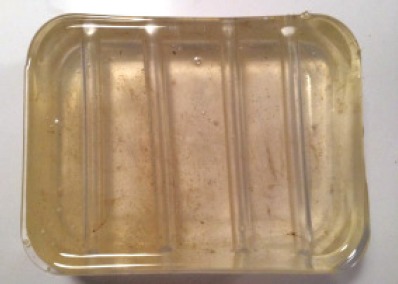
Gel model with four phantom lumens.
Figure 8.
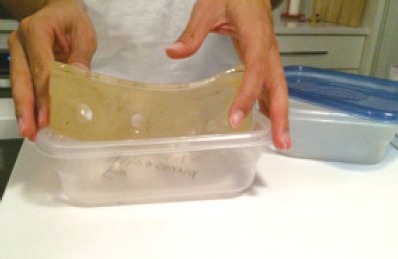
One side of the gel tilted out of the model’s container in order to fill the lumens with liquid.
RESULTS
A transparent and durable ultrasound phantom we produced was clear and contained four vessel lumens. The images obtained using these phantoms are of high quality (Figure 9) and are compared well to normal sonographic anatomy.
Figure 9.
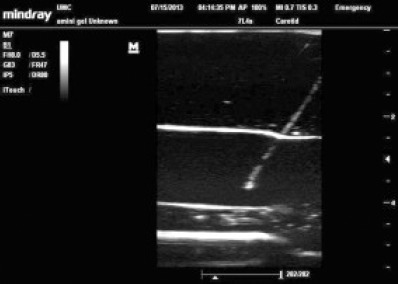
Ultrasound image of clear ballistic phantom with a needle in vessel.
DISCUSSION
POC ultrasound can be used to help practice or perform many emergency procedures. From obtaining peripheral intravenous (IV) access to performing a lumbar puncture, sonographers must develop skills that require hand-eye coordination as well as spatial orientation skills. Many protocols exist for teaching and learning these skills; however the one basic necessity is practice. Unfortunately, without appropriate training models that are life-like and long lasting, practicing these skills can prove difficult.
The components of the phantom model described in this paper are unique when compared with other materials used to create models. It is unlike gelatin models, which need to be refrigerated, and it does not tear easily. In addition, unlike agar, which requires refrigeration, this material does not decompose. Furthermore, this material does not require mixing with other agents such as fiber, gauze, and sawdust to create tissue like densities. Finally, when creating peripheral IV models as described above there is no need for latex tubing to remain inside the phantom. This is beneficial because latex tubing can become porous with numerous punctures. With this model, the molding technique creates cylindrical lumens that can retain fluid, self-seal, and can be aspirated to demonstrate evidence of needle placement.
The clear ballistic brand gel is unique because it does not dry out, it does not decay, and it is reusable. The material is clear which allows trainees to have direct visual access to the vessel in order to correlate with the ultrasound images as well as to confirm proper needle placement. The authors have used the gel phantom to train over fifty hospital staff and residents without the need for replacement. Lastly, it has not been refrigerated for over three years, and it shows no signs of decay. We believe that phantoms made of clear ballistic brand gel are an excellent alternative to commercially available expensive phantoms to teach ultrasound guided vascular access.
Making home-made phantoms requires more time when compared to purchasing professional models. Although ballistic gel has an unlimited life span, it may become slightly yellowed when reused numerous times. Ballistic gel is transparent, which allows the practitioner to adjust needle guidance with direct visualization if needed. This feature is not realistic to a clinical scenario, however may assist a novice practitioner. We did not evaluate the phantom’s effectiveness in this study. We did not conduct a direct comparison study of performance between a commercial phantom and the low-cost ballistic gel phantom.
In conclusion, clear ballistic gel can be used to make ultrasound-training models quickly and inexpensively. These phantoms are reusable like the commercially available training models and can be used to teach ultrasound-guided procedures with only a fraction of the cost. This ballistic gel is sold by clear ballistic gel in blocks as small as 1 lb and is sold for $9.52 per lb. As described above, this gel can be used to create a model for peripheral IV placement; however the possibilities are limitless and future research may yield advantages in the creation of other ultrasound models.
Footnotes
Funding: None.
Ethical approval: Not needed.
Conflicts of interest: The authors declare that there are no competing interest and relationships with other people or organizations that could inappropriately influence their work.
Contributors: Amini R proposed the study and wrote the first draft. All authors read and approved the final manuscript.
REFERENCES
- 1.American Board of Emergency Medicine. The Emergency Medicine Milestone Project. ABEM Web site. [Accessed October 14, 2014]. Available at: https://www.abem.org/public/docs/default-source/migrated-documents-and-files/em-milestones.pdf?sfvrsn=4 .
- 2.Xu D, Abbas S, Chan VW. Ultrasound phantom for hands-on practice. Reg Anesth Pain Med. 2005;30:593–594. doi: 10.1016/j.rapm.2005.08.007. [DOI] [PubMed] [Google Scholar]
- 3.Kendall JL, Faragher JP. Ultrasound-guided central venous access: a homemade phantom for simulation. CJEM. 2007;9:371–373. doi: 10.1017/s1481803500015335. [DOI] [PubMed] [Google Scholar]


